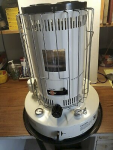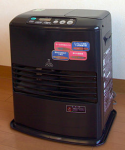Paulg25
Well-known member
Just discovered them. Seem popular in Japan and some parts of Europe. Any views/opinions on these?
I don't think that's the case.Basically just an old syle paraffin heater with electric ignition and electronic thermostat and timer controls needing a 230V mains supply.
You're right not surprisingly they have advanced since the old Aladdin heaters of 50 years ago as they are still common heaters over in Japan. I've got one of these, very clean hot flame, very minimal smell and moisture. Mine has a pot holder wire guard on top, plenty hot enough to cook on. Mostly lives in the attic for powercuts that don't happen but I did use it in a van and mobo for short periods with good results.I don't think that's the case.


My round one that doesn't look anything fancy also burns with a blue flame if its set right. Presumably the heat is recirculated to have a similar heating of the fuel before it ignites. I'm not sure like I say if there is an equation of how much water is given off per amount of paraffin burned that can't be cheated but I expect the old type at least were not efficient so with these we might be seeing paraffin at its best which is a damn sight better than it used to be.Found this...
The Japanese non-vented "fan" heater burns kerosene gas and is known as a gasification type heater. The liquid kerosene fuel is pre-heated via an electric heating element to vaporize the fuel. The resulting gas is collected and forced into the burn chamber where it is ignited and burns with a blue flame, similar to propane.
View attachment 113209
Exactly the hydrocarbon fuel you use has an amount of carbon and hydrogen. Heavier fuels like kero and diesel have more carbon lighter fuels like gas more hydrogen. The hydrogen in being burnt must give off water as vapour unless it can be collected. The carbon becomes CO2 providing there is enough oxygen supply. Any shortage of oxygen means Carbon becomes CO (carbon monoxide a deadly poison) There is no way to avoid these basic facts no matter hop much electronics. Only option is warning systems and lots of ventilation. ol'willI think I am correct in saying that Inverter is a brand name not a technology.
Every litre of paraffin burned in any heater without a flue will produce exactly the same ammount of water vapour. There is still always a CO risk, and they do require a mains supply. Not ideal for a boat.
Exactly the hydrocarbon fuel you use has an amount of carbon and hydrogen. Heavier fuels like kero and diesel have more carbon lighter fuels like gas more hydrogen. The hydrogen in being burnt must give off water as vapour unless it can be collected.
Interesting. So kero will produce less water that propane? Any idea how much less?CxHy + O2 --> CO2 + H2O + heat (unbalanced...)"
You can avoid the CO, you cannot avoid the H20.
I spend winter in a marina with 240v available.and they do require a mains supply. Not ideal for a boat.
I'd agree its not the ideal thing for a boat unless flued. I've had old style paraffin heaters and they are just a basic wick burner same as a big oil lamp. These jap heaters are really more advanced than that so may well be better or as good as a gas heater. Not sure on energy density but if paraffin is more dense than liquefied gas it would be worth considering. Less explody too.Not sure why you would want a paraffin heater if you have 240v. They are popular in some countries in the world where kerosene/paraffin is a common fuel for domestic heating, usually because gas is not available. In the UK it has not been a popular fuel for many years simply because the alternatives are superior. Consequently the fuel is hard to find, unlike when I was young when the Esso Blue and Pink bowsers did the rounds 2 or 3 times a week. Disappeared when natural gas came in and portable bottled gas heaters came on the market.
Personally I would not have paraffin as a heating source on a boat unless like a Taylors or Dickinson it had an external flue. If you have 240v there are much better alternatives though.
Entirely agree, especially as regards having a fuel-burning heater. An unflued fuel-burning heater a) inevitably increases the humidity in the cabin - the simple chemistry of burning fuel means that you unavoidably get (roughly) the same weight of water in the air as that of the fuel you burn and b) has the potential to generate Carbon Monoxide if there is any maladjustment of the burner. The difference between a well-adjusted burner and a killer is MUCH less than people imagine; you're always walking a tightrope with a blue-flame burner. I've posted before to note I've seen the results of (sadly, unpublished) tests that show that even a well-adjusted and maintained primus type burner is on the borderline for CO emissions; the tests were done in relation to the safety of using them in tents in the Antarctic.Not sure why you would want a paraffin heater if you have 240v. They are popular in some countries in the world where kerosene/paraffin is a common fuel for domestic heating, usually because gas is not available. In the UK it has not been a popular fuel for many years simply because the alternatives are superior. Consequently the fuel is hard to find, unlike when I was young when the Esso Blue and Pink bowsers did the rounds 2 or 3 times a week. Disappeared when natural gas came in and portable bottled gas heaters came on the market.
Personally I would not have paraffin as a heating source on a boat unless like a Taylors or Dickinson it had an external flue. If you have 240v there are much better alternatives though.
I also remember the constant need to prick the jet. Horrendous things. I wonder if thats a problem when you have a jet for gas where liquid goes through at the beginning and burns sooty or if it was dirty fuel? And if the jap heaters suffer similar. I doubt they possibly could sell something as unreliable as a primus stove.* The older members will remember the Primus stove.
Thats interesting then. So better to choose a quality little paraffin heater than an unflued propane heater which are widely sold these days. The camping stove gas bottle types. If that sort of heater is wanted for portability reasons or cost.the equation for the combustion of aliphatic hydrocarbons (i.e. paraffin, diesel, petrol, butane or propane) means that for every 14 grams of fuel burnt, you get about 18 grams of water (the figures are approximate but near enough for the fuels we use); it's actually worse for lighter fuels such as propane and butane.